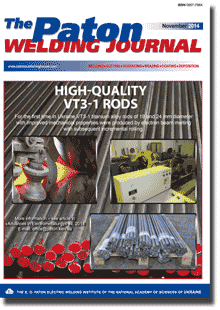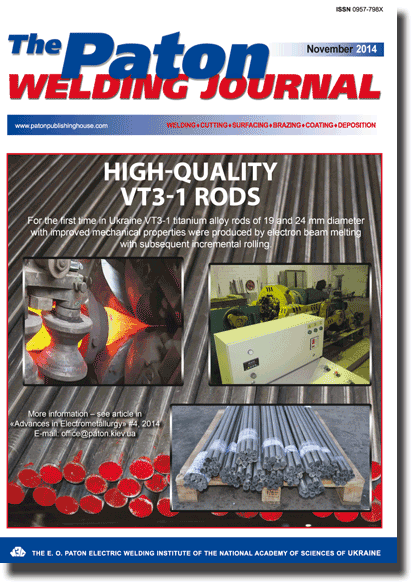Access for download PDF files for subscribers and for reviewers of scientometric bases.
Organization: Elsevier for content access(PDF files of journals released before 2024 are available for download from the website's archives))
Organization: Elsevier for content access(PDF files of journals released before 2024 are available for download from the website's archives))
| 2014 №11 (07) |
DOI of Article 10.15407/tpwj2014.11.08 |
2014 №11 (09) |

The Paton Welding Journal, 2014, #11, 42-45 pages
EFFECTIVENESS OF STRENGTHENING BUTT WELDED JOINTS AFTER LONG-TERM SERVICE BY HIGH-FREQUENCY MECHANICAL PEENING
V.V. KNYSH, S.A. SOLOVEJ and A.Z. KUZMENKO
E.O. Paton Electric Welding Institute, NASU. 11 Bozhenko Str., 03680, Kiev, Ukraine. E-mail: office@paton.kiev.ua
Abstract
Cyclic fatigue life of butt welded joints of low-alloyed steel 09G2S, strengthened by the technology of high-frequency mechanical peening (HFMP) at different stages of fatigue fracture: in as-welded state, after accumulation of 70 % of fatigue damage, at formation of surface fatigue cracks, was studied. The objective of these studies is establishing the effectiveness of application of HFMP treatment of butt welded joints after long-term service at alternating loading. It is shown that strengthening of butt welded joints by HFMP right after welding increases the endurance limit (2 mln cycle base) by 50 % - from 180 up to 270MPa, and cyclic fatigue life - by 5 to 10 times. It is experimentally confirmed that the effectiveness of strengthening welded joints with 70 % accumulated fatigue damage depends on the levels of applied maximum stresses before strengthening. So, residual cyclic fatigue life of samples, tested in the range of maximum 240-260 MPa stresses, falls within the scatter band of experimental data for welded joints in unstrengthened condition, and for those tested in the range of maximum stresses of 280-300MPa it is within the scatter band of experimental data for welded joints strengthened by HFMP technology in as-welded condition. It is established that application of HFMP technology improves the residual cyclic fatigue life of welded joints with surface fatigue cracks (down to 2 mm deep) 2.5 times compared to fatigue life before crack formation. 11 Ref., 5 Figures.
Keywords: high-frequency mechanical peening, increase of cyclic fatigue life, fatigue, welded joint, accumulated fatigue damage
Received: 04.04.14
Published: 28.11.14
References
1. Kuhlmann, U., Duerr, A., Guenter, P. et al. (2005) Verlaengerung der Lebensdauer von Schweisskonstruktion aus hoeher festen Baustaehlen durch Anwendung der UIT-Technologie. Schweissen und Schneiden, 57(8), 384-391.
2. Lobanov, L.M., Kirian, V.I., Knysh, V.V. et al. (2006) Improvement of fatigue resistance of welded joints in metal structures by high-frequency mechanical peening (Review). The Paton Welding J., 9, 2-8.
3. Yin, D., Wang, D., Jing, H. et al. (2010) The effects of ultrasonic peening treatment on the ultra-long life fatigue behavior of welded joints. Materials & Design, 31(7), 3299-3307. https://doi.org/10.1016/j.matdes.2010.02.006
4. Martines, L.L. (2010) Fatigue life extension procedure by ultrasonic peening. IIW Doc. XIII-2316-10.
5. Yildirim, H.C., Marquis, G.B. (2011) Overview of fatigue data for high frequency treated welded joints. IIW Doc. XIII-2362r1-11.
6. Abdullah, A., Malaki, M., Eskandari, A. (2012) Strength enhancement of the welded structures by ultrasonic peening. Materials & Design, 38, 7-18. https://doi.org/10.1016/j.matdes.2012.01.040
7. Garf, E.F., Litvinenko, A.E., Smirnov, A.Kh. (2001) Assessment of fatigue life of tubular connections subjected to ultrasonic peening treatment. The Paton Welding J., 2, 12-15.
8. Kudryavtsev, Y., Kleiman, J., Lugovskoy, A. et al. (2006) Fatigue life improvement of tubular welded joints by ultrasonic peening. IIW Doc. XIII-2117-06.
9. Zhao, X., Wang, D., Huo, L. (2011) Analysis of the S-N curves of welded joints enhanced by ultrasonic peening treatment. Materials & Design, 32(1), 88-96. https://doi.org/10.1016/j.matdes.2010.06.030
10. Knysh, V.V., Solovej, S.A., Kuzmenko, A.Z. (2011) Influence of preliminary cyclic loading on effectiveness of welded joint strengthening by high-frequency peening. The Paton Welding J., 10, 36-39.
11. Knysh, V.V., Kuzmenko, A.Z., Solovej, S.A. (2009) Increase of cyclic fatigue life of tee welded joints with surface cracks. Ibid., 1, 29-33.
Suggested Citation
V.V. Knysh, S.A. Solovej And A.Z. Kuzmenko (2014) Effectiveness of strengthening butt welded joints after long-term service by high-frequency mechanical peening. The Paton Welding J., 11, 42-45.The cost of subscription/purchase order journals or individual articles
| Journal/Currency | Annual Set | 1 issue printed |
1 issue |
one article |
| TPWJ/USD | 384 $ | 32 $ | 26 $ | 13 $ |
| TPWJ/EUR | 348 € | 29 € | 24 € | 12 € |
| TPWJ/UAH | 7200 UAH | 600 UAH | 600 UAH | 280 UAH |
| AS/UAH | 1800 UAH | 300 UAH | 300 UAH | 150 UAH |
| AS/USD | 192 $ | 32 $ | 26 $ | 13 $ |
| AS/EUR | 180 € | 30 € | 25 € | 12 € |
| SEM/UAH | 1200 UAH | 300 UAH | 300 UAH | 150 UAH |
| SEM/USD | 128 $ | 32 $ | 26 $ | 13 $ |
| SEM/EUR | 120 € | 30 € | 25 € | 12 € |
| TDNK/UAH | 1200 UAH | 300 UAH | 300 UAH | 150 UAH |
| TDNK/USD | 128 $ | 32 $ | 26 $ | 13 $ |
| TDNK/EUR | 120 € | 30 € | 25 € | 15 € |
AS = «Automatic Welding» - 6 issues per year;
TPWJ = «PATON WELDING JOURNAL» - 12 issues per year;
SEM = «Electrometallurgy Today» - 4 issues per year;
TDNK = «Technical Diagnostics and Non-Destructive Testing» - 4 issues per year.


